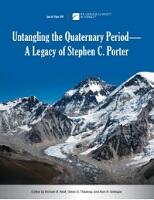Griffing, Corinne Y.
Person Preferred Name
Corinne Y. Griffing
Affiliation
Related Works
Content type
Digital Document
Abstract
The CRREL permafrost tunnel offers a unique opportunity to sample ice wedges in a climate-controlled environment, penetrating frozen silts which host massive ground ice that may record Dansgaard-Oeschger (D-O) and Heinrich Events. Ice wedges in the tunnel have been dated to approximately 36-22 ka (Hamilton et al., 1988), allowing the paleoclimate of the region to be reconstructed during MIS 3, when D-O and Heinrich events were documented in various other records. These climate cycles are rapid climate oscillations that have been recognized in records from the Arctic and subarctic, and suggest that climate can rapidly shift by 10°C over millennial scale times. I hypothesize that climate in the interior of Alaska varied with Heinrich events during MIS 3, and that these events were recorded as stable isotope variations in local permafrost ground ice. To test this hypothesis, I sampled aQ LFH ZHGJH LQ WKH SHUPDIURVW WXQQHO IRU 182 ' DQG 14C to obtain a detailed climate record from central Alaska.
18O values from within the wedge display a gradual decrease of 5.95‰ from the center toward the left edge, interpreted to reflect decreasing temperature, and is the same magnitude of decrease seen during the transition from the warm D-O interstadial 5 to the cold of Heinrich Event 3 in the NGRIP record in Greenland. Radiocarbon dates from within the wedge range from 28 – 37 cal kyr BP, and are interpreted here not to be the same age as the ice, but rather represent warm periods when sediment aggraded prior to ice wedge growth. These results suggest that D-O and Heinrich events impacted Late Pleistocene climate and ground ice in central Alaska.
Origin Information
Content type
Digital Document
Abstract
Book Chapter: Uplift of the central Andes during the Miocene was followed by large-scale reorganization of Atlantic-draining rivers in Argentine Patagonia. Here, we document the abandonment of one large river in the late Pliocene and the establishment of the modern drainage in the Early Pleistocene. A chronology for these events is provided by 40Ar/39Ar ages on basalt flows. Remnants of the Pliocene paleovalley system are well preserved in the Lago Cardiel–Gobernador Gregores area, where they are eroded into flat-lying basalt flows dated from ca. 13.9 Ma to 8.6 Ma. Younger basalts that erupted onto the abandoned floor of the paleovalley are as young as 3.7 Ma. Abandonment of the Pliocene paleovalley and establishment of the modern Río Chico and Río Shehuen catchments happened near the close of the Pliocene when Andean glaciers incised the east-sloping pediment on which the late Miocene drainage was established. Lago Cardiel sits within a large endorheic basin that is inset into the late Pliocene paleovalley. The basin began to develop just before 4 Ma, after the paleovalley was abandoned. It became larger and deeper during the Pleistocene due to mass movements along its margins, deflation of the basin floor during times when Lago Cardiel was dry or nearly dry, and possibly lowering along bounding faults. The Pliocene–Pleistocene landscape and drainage changes that we have documented are not unique to the Lago Cardiel–Gobernador Gregores area; similar changes are apparent elsewhere in Patagonia east of the crest of the Andes.
Book: Stephen C. Porter was an international leader in Quaternary science for several decades, having worked on most of the world’s continents and having led international organizations and a prominent interdisciplinary journal. His work influenced many individuals, and he played an essential role in linking Chinese Quaternary science with the broader international scientific community. This volume brings together nineteen papers of interdisciplinary Quaternary science honoring Porter. Special Paper 548 features papers from six continents, on wide-ranging topics including glaciation, paleoecology, landscape evolution, megafloods, and loess. The topical and geographical range of the papers, as well as their interdisciplinary nature, honor Porter’s distinct approach to Quaternary science and leadership that influences the field to this day.
Origin Information
Content type
Digital Document
Abstract
This thesis advances understanding of late Cenozoic landscape evolution and glaciation in southernmost South America using continental sedimentary deposits and landforms in the Lago Cardiel region in the foothills of the southern Patagonian Andes and along the Atlantic north and south of the Strait of Magellan. The evolution of the landscape in these two areas was determined through landform mapping and relative chronologic landform correlations. Paleomagnetic characteristics of late Cenozoic sediments and basalt flows and the stratigraphy and sedimentology of Pleistocene glacial sediments in sea cliffs and anthropogenic exposures provide a chronology and evidence of depositional environments during Pleistocene glaciations. The landscape in the Lago Cardiel area changed significantly following the last major period of tectonic uplift at the end of the Miocene. Large west-trending valleys that incise Miocene-aged basalt were abandoned by their formative rivers about 4.4 Ma. The closed basin that contains Lago Cardiel began to form on the relict plain surface before 4.0 Ma and grew in size throughout the Pliocene and Pleistocene by a combination of erosion by small streams, deflation, colluviation, and possibly tectonic collapse. Drainage reorganizations occurred at about 4.0 Ma and 3.6 Ma, most likely initiated by increased aggradation or isostasy during Pliocene glaciations. Eolian, fluvial, and mass-movement processes continued to alter the landscape throughout the Pleistocene with higher rates during glacial periods. Evidence of at least three glaciations is recorded in the stratigraphic exposures at the Atlantic Coast and the shores of the Strait of Magellan. At Cabo Vírgenes and Bahía Posesión, two glacial drift units were deposited in a grounding-line environment. These sediments are normally magnetized and date to the Brunhes Chron (<0.78 Ma). The Tres de Enero highway cut exposes three subglacial tills deposited during the Great Patagonian Glaciation (GPG) – two normally magnetized tills that I assign to the early Brunhes Chron and a lower reversely magnetized till deposited during the Matuyama Chron (2.581-0.78 Ma). The reversely magnetized till and other reversely magnetized GPG sediments indicate that the earliest Pleistocene glaciations occurred before 0.78 Ma. In the Río Gallegos Valley, a 0.86 Ma basalt flow caps a thick unit of normally magnetized glaciofluvial gravel, which was probably deposited during the Jaramillo Subchron (1.075-0.991 Ma). This thesis provides a timeline for the evolution of the landscape of the Lago Cardiel region from the Miocene to the present. It also contributes to our understanding of the age and depositional environments of GPG and post-GPG 1 glacial events in the Strait of Magellan region by documenting the magnetic polarity of glacial sediments throughout the region.
Origin Information


